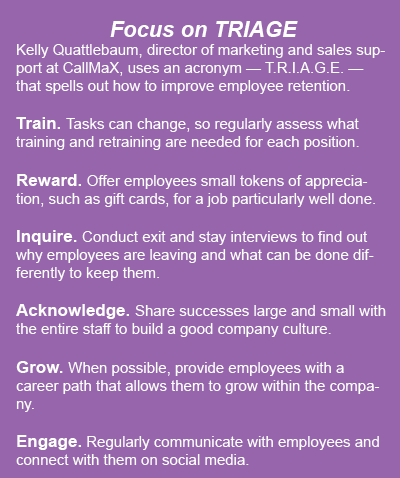High employee turnover hurts a company’s bottom line. Training and development experts offer advice from the trenches on improving employee retention.
It’s the nature of the beast in student housing: Residents come and go on a regular basis. However, it’s a major financial drain on the company when this occurs with community staff.
Employee retention isn’t rocket science, but it does require some work. Four training and development experts offer specific pieces of advice for increasing employee satisfaction and reducing turnover.
Focus on the Hiring Process
The hiring process is where retention begins, and it might be time to update the process, says Pattie Woods, vice president of training and development at Fogelman Management Group. “We’re not hiring the same people we were looking for 10 years ago,” Woods says. “The skill sets have changed. Change up your interview questions to make sure you get the right fit.”
A more thorough onboarding process can also help with retention. Don’t just hand over the keys and see if employees can sink or swim, Woods says, suggesting a slow and steady onboarding process. Consider offering training webinars that new staff can take over their first month or so.
Wood is also a big proponent of stay interviews, as opposed to exit interviews. Instead of trying to figure out why employees are leaving after they’ve made that decision, talk with them about their likes and dislikes while they are on the job. Then use that information to make changes that will improve retention.
Mine Turnover Data
The devil is often in the details, and that’s particularly true with data. Sometimes a good overall retention rate is hiding a problem in one key position. That’s what happened for Christine D. Richards, chief operating officer and executive vice president at EdR.
In the fall of 2013, EdR’s employee turnover rate was 30.9 percent, which lined up nicely with the overall multifamily rate of 31.5 percent. However, Richards noticed that she was being asked to speak at an increasing number of training sessions for leasing and marketing managers.
When she asked HR to look at turnover by position, she found out that “although the company average was 30 percent, our leasing and marketing manager turnover was 48 percent,” Richards says.
The reason? EdR’s compensation for leasing and marketing managers was significantly lower than that of her competitors — in some cases by up to $10,000. So in October 2013, based on geographic location, direct reports, beds in the community and tenure with the company, EdR implemented a new compensation strategy for this position, making salaries competitive with those offered by other employers.
“Fast-forward seven months later, to May 2014, and our turnover rate for leasing and marketing managers dropped to 26 percent from 48 percent in August,” Richards says. “The big house might look fine, but sometimes you have to look into the details to make sure you are covering all of your bases.”

Build a Better Company Culture
Employees want to stay at companies that provide a good work environment. And Peak Campus Management appears to have that.
In 2014, the Atlanta Journal-Constitution named Peak Campus the No. 3 best small company to work for, and the previous year, the Atlanta Business Chronicle named the company a top place to work. Peak Campus is earning these honors by making engaging with its communities the centerpiece of the company’s culture, according to Sandra Barfield, vice president of training and operations support.
Specifically, Peak Campus offers employees wellness programs and community service opportunities, engages with them on social media, celebrates success and creates a fun work environment.
The wellness programs — including smoking-cessation programs and weight-loss and fitness programs — and community service opportunities are particularly popular with employees. “We believe that good health leads to better productivity at work, and the residual effects are better leasing numbers,” Barfield explains. Peak Cares, the community service program, allows employees in each of the company’s markets to give back in the ways that feel right for their communities.
This employee-centered culture starts at the top. “We really focus, as a leadership team, on what we are doing to support our communities,” Barfield says. “In our Atlanta corporate office, we have a big branded sign that says, ‘What have you done for the field lately?’”
Want More?
Woods, Richards, Barfield and Quattlebaum covered these ideas and more at the “Dramatically Improve Employee Retention” session at last month’s 2015 NAA Student Housing Conference & Exposition. An audio-synced PowerPoint recording of this session can be purchased from REWIND.

